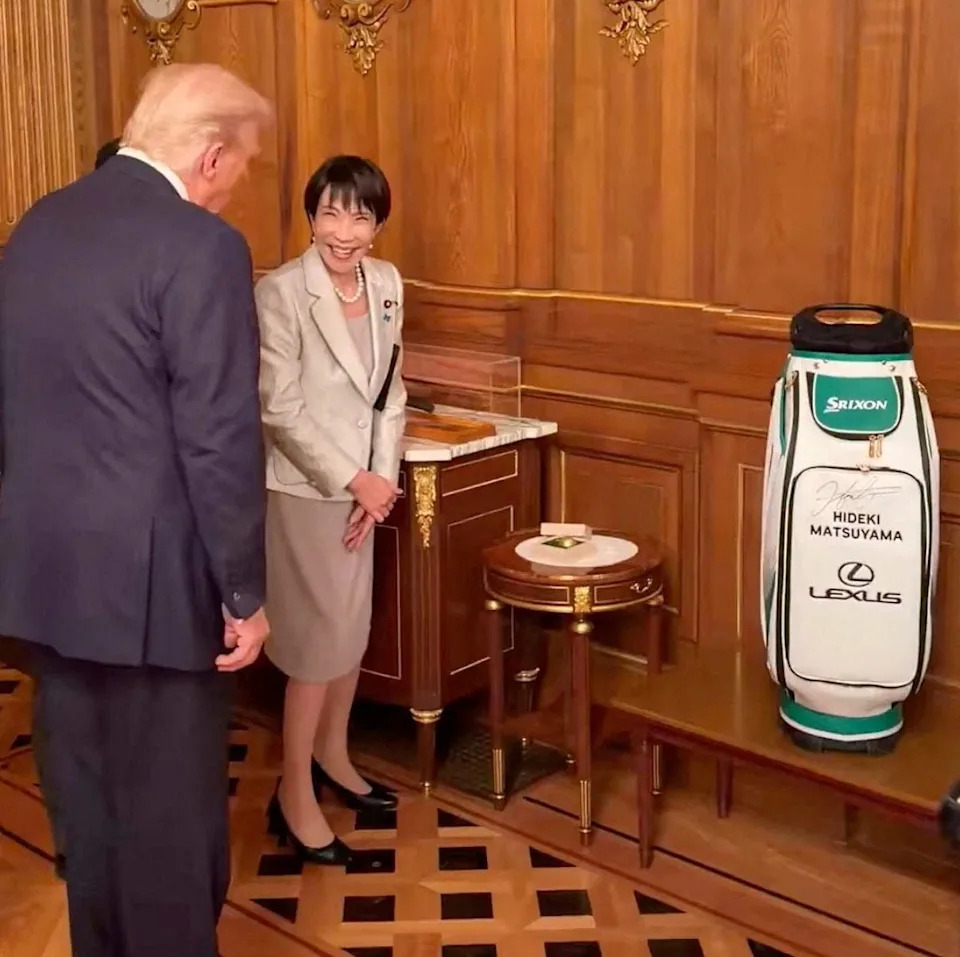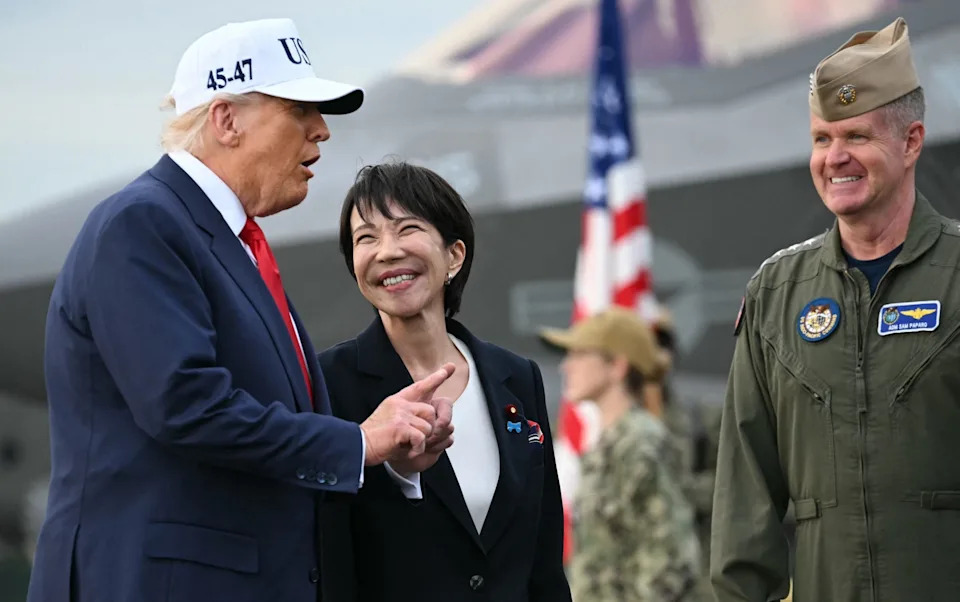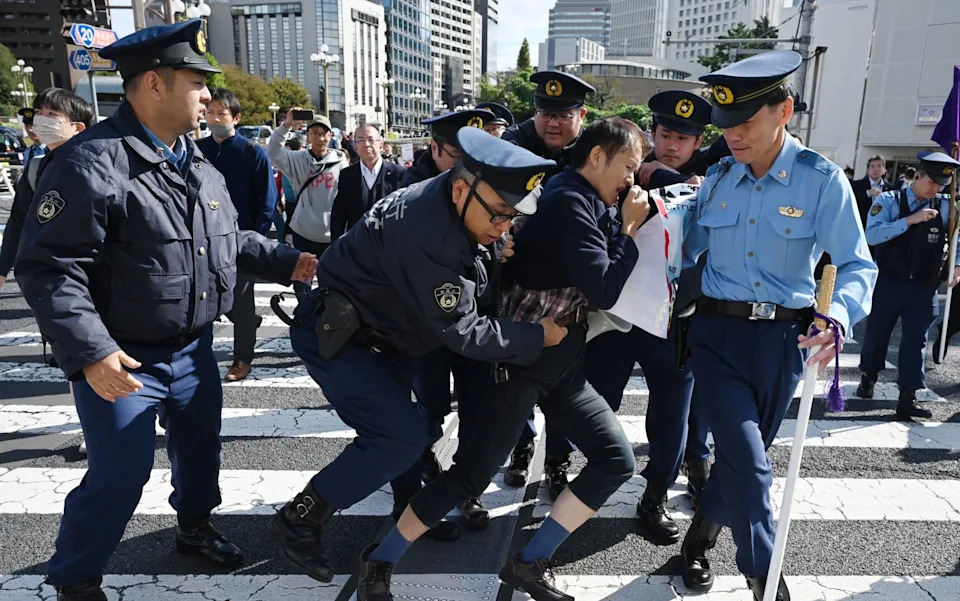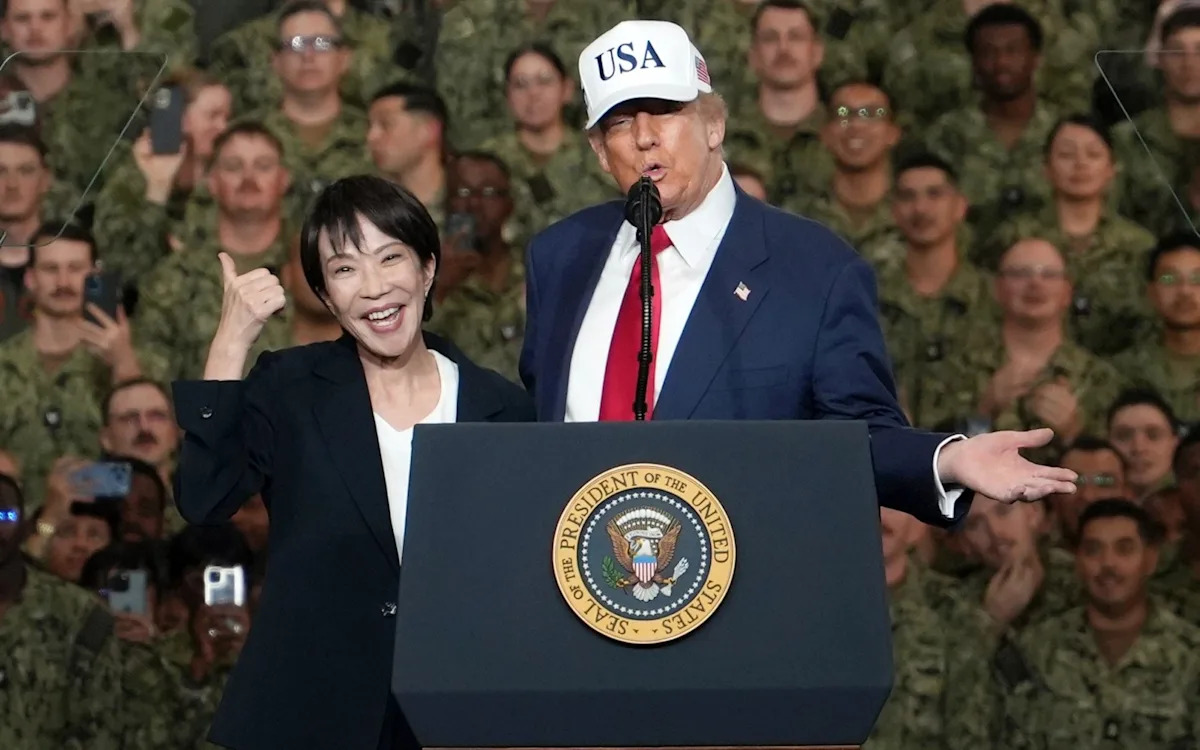Japan’s new prime minister laid it on thick.
There was the gift of 250 cherry trees for America’s 250th anniversary next year; a putter used by Shinzo Abe, the late, former prime minister with whom Donald Trump developed a close relationship; and another nomination for the Nobel Peace Prize.
In return, Mr Trump spoke warmly of his host, Sanae Takaichi, Japan’s own Iron Lady, telling her: “We are an ally at the strongest level.”
And there were documents to be signed. One covered a deal to work together on expanding the supply chain for rare earth minerals deal; the other was a vague understanding of future cooperation.
“The two leaders instructed relevant ministers and secretaries to take further steps for a NEW GOLDEN AGE of the ever-growing US Japan Alliance,” it said.
It was a day of style rather than substance.

Ms Takaichi presents Mr Trump with a gold leaf ball and a golf bag signed by Hideki Matsuyama – Margo Martin /X
Hanging over it all, unmentioned, was a tricky bit of business. How to move forward on Japan’s promise to invest $550bn (£4.1bn) in the US?
It was agreed in July, bringing a promise to reduce American tariffs on Japanese goods to 15 per cent.
But Tuesday events at the palace came and went with no concrete details of how the money (equivalent to more than 10 per cent of Japan’s economy) would be spent.
It is a sign, say experts, that Mr Trump’s very personal form of diplomacy is often a success in generating headlines but is not always so useful in delivering his stated objective of rebalancing global trade.
A senior Western diplomat said the deals announced on Tuesday had not changed his view.

Donald Trump bonded with Ms Takaichi over their shared admiration for Shinzo Abe – ANDREW CABALLERO-REYNOLDS/AFP via Getty Images
“Despite all the noise, my assessment remains the same; structural competition is here to stay and any ‘deal’ is likely niche and will not tackle the fundamentals,” he said.
Mr Trump spent the third day of his Asia trip in Japan. Later in the day he addressed American troops aboard the USS George Washington, but it started amid the gilded splendour of the Akasaka Palace in Tokyo.
He bonded with Ms Takaichi over their shared admiration for Abe: He as a fellow conservative world leader, and she as one of his political protégés.
They met beneath an ornate ceiling featuring a mural of Aurora, the Roman goddess of dawn.
“Prime minister Abe often told me about your dynamic diplomacy,” Ms Takaichi told Mr Trump, and thanked him for hosting the former prime minister’s widow at Mar-a-Lago last year.

Police move an anti-Trump protester near the Akasaka Palace – GREG BAKER/AFP
As they shook hands, Mr Trump said: “He was a great friend of mine and a great friend of yours.”
Abe was the first foreign leader to visit Mr Trump after his shock 2016 election victory.
When Mr Trump visited in 2019, Abe took him for a round of golf and Ms Takaichi demonstrated that she had learned something about handling her mercurial guest.
She gave the president a gold bag signed by Hideki Matsuyama, the putter, and a map of the places where Japan planned to invest money.
The White House later said the Japanese government had also nominated Mr Trump for the Nobel Peace Prize.
Mr Trump has made no secret of his belief that his work ending conflict around the world was worthy of recognition although the Japanese government said it could not comment on the matter because of rules of confidentiality around nominations.

Mr Trump greets troops at the US Navy’s USS George Washington – PHILIP FONG/AFP
Then there was work to be done, in the form of signing two agreements beneath the chandeliers of the neo-Baroque palace.
It included a rare earths deal – crucial in making everything from mobile phones to electric cars – as both countries look to reduce their reliance on China, which is responsible for 90 per cent of world production.
China has used its position to create a chokepoint for supplies as it goes toe-to-toe with Washington in a trade battle.
Under the terms of the deal, Japan and the US will use economic policy tools and coordinated investment to speed up the “development of diversified, liquid, and fair markets for critical minerals and rare earths”.
The agreements, although vague, plus the golf gear and goodwill, seem to have been enough to please Mr Trump.
Firms looking at US investment
There was more in the evening, when the Japanese government issued a list of companies interested in investing in the US.
Westinghouse, a nuclear equipment supplier, for example, said it was looking at building reactors and smaller modular reactors worth up to $100bn.
And at a meeting of company chief executives at the American ambassador’s residence, Mr Trump said Toyota stood ready to invest $10bn in manufacturing plants.
Under the terms of the deal, Mr Trump has final say over whether the investments go ahead and he could yet reimpose higher tariffs if Japan fails to fund his choices.
But Ms Takaichi has passed her first test, forming a friendly relationship with Mr Trump. They can fill in the gaps on who spends what, where and when later.

